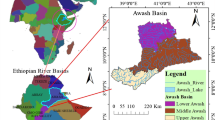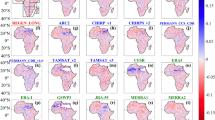Abstract
We dynamically downscaled Japanese reanalysis data (JRA-25) for 60 regions of Japan using three regional climate models (RCMs): the Non-Hydrostatic Regional Climate Model (NHRCM), modified RAMS version 4.3 (NRAMS), and modified Weather Research and Forecasting model (TWRF). We validated their simulations of the precipitation climatology and interannual variations of summer and winter precipitation. We also validated precipitation for two multi-model ensemble means: the arithmetic ensemble mean (AEM) and an ensemble mean weighted according to model reliability. In the 60 regions NRAMS simulated both the winter and summer climatological precipitation better than JRA-25, and NHRCM simulated the wintertime precipitation better than JRA-25. TWRF, however, overestimated precipitation in the 60 regions in both the winter and summer, and NHRCM overestimated precipitation in the summer. The three RCMs simulated interannual variations, particularly summer precipitation, better than JRA-25. AEM simulated both climatological precipitation and interannual variations during the two seasons more realistically than JRA-25 and the three RCMs overall, but the best RCM was often superior to the AEM result. In contrast, the weighted ensemble mean skills were usually superior to those of the best RCM. Thus, both RCMs and multi-model ensemble means, especially multi-model ensemble means weighted according to model reliability, are powerful tools for simulating seasonal and interannual variability of precipitation in Japan under the current climate.


















Similar content being viewed by others
References
Adachi SA, Kimura F, Tanaka M (2009) Reproducibility of past 20 years climate using dynamical downscaling method and future prediction of snow cover in winter. Bull Terrestrial Environ Res Center Univ Tsukuba 10:51–60
Arritt RW, Rummukainen M (2011) Challenges in regional scale climate modeling. Bull Am Meteorol Soc 92:365–368
Barnston AG, Li S, Mason SJ, Dewitt DG, Goddard L, Gong X (2010) Verification of the first 11 years of IRI’s seasonal climate forecasts. J Appl Meteorol Climatol 49:493–520. doi:10.1175/2009JAMC2325.1
Buser CM, Kunsch HR, Schar C (2010) Bayesian multi-model projections of climate: generalization and application to Ensemble results. Clim Res 44:227–241
Chen DX, Coughenour MB (1994) GEMTM: a general model for energy and mass transfer of land surfaces and its application at the FIFE sites. Agric For Meteorol 68:145–171
Chen F, Dudhia J (2001) Coupling an advanced land-surface/hydrology model with the Penn State/NCAR MM5 modeling system. Part I: Model description and implementation. Mon Weather Rev 129:569–585
Christensen JH, Raisane J, Iversen T, Bjorge D, Christensen OB, Rummukainen M (2001) A synthesis of regional climate change simulations—a Scandinavian perspective. Geophys Res Lett 28:1003–1006. doi:10.1029/2000GL012196
Christensen JH, Timothy RC, Rummukainen M, Amanatidis G (2007) Evaluating the performance and utility of regional climate models: the PRUDENCE project. Clim Change 81:1–6. doi:10.1007/s10584-006-9211-6
Christoph M, Buser HRK, Luthi D, Wild M, Schar C (2009) Bayesian multi-model projection of climate: bias assumptions and interannual variability. Clim Dyn. doi:10.1007/s00382-009-0588-6
Dairaku K, Emori S (2007) Potential hydrological change resulting from greenhouse warming: climate change and water-related disasters of severe tropical storms in East Asia. Research Signpost “Geophysics”. In: Tomonori M, Ryuichi K (eds), pp 105–123
Dairaku K, Emori S, Nozawa T (2008) Impacts of global warming on hydrological cycles in the Asian monsoon region. Adv Atmos Sci 25(6):960–973
Eastman JL, Coughenour MB, Pielke RA Sr (2001) Does grazing affect regional climate? J Hydrometeorol 2:243–253
Feng J, Lee DK, Fu C, Tang J, Sato Y, Kato H, Mcgregor JL, Mabuchi K (2011) Comparison of four ensemble methods combining regional climate simulations over Asia. Meteorol Atmos Phys 111:41–53
Fowler JH, Ekstrom M (2009) Multi-model ensemble estimates of climate change impacts on UK seasonal precipitation extremes. Int J Climatol 29:385–416
Gao X, Xu Y, Zhao Z, Pal JS, Giorgi F (2006) On the role of resolution and topography in the simulation of East Asia precipitation. Theor Appl Climatol 86:173–185. doi:10.1007/s00704-005-0214-4
Giorgi F, Marinucci MR (1996) An investigation of the sensitivity of simulated precipitation to model resolution and its implications for climate studies. Mon Weather Rev 124:148–166
Hara M, Yoshikane T, Kawase H, Kimura F (2008) Estimation of the impact of global warming on snow depth in Japan by the pseudo-global-warming method. Hydrol Res Lett 2:61–64
Hirai M, Sakashita T, Kitagawa H, Tsuyuki T, Hosaka M, Oh’izumi M (2007) Development and validation of a new land surface model for JMA’s operational global model using the CEOP observation dataset. J Meteorol Soc Jpn 85:1–24
Iizumi T, Nishimori M, Dairaku K, Adachi SA, Yokozawa M (2011) Evaluation and intercomparison of downscaled daily precipitation indices over Japan in present-day climate: strengths and weaknesses of dynamical and bias-correction-type statistical downscaling methods. J Geophys Res 116. doi:10.1029/2010JD014513
Ishihara K (2010) Assessment for the 30-Year daily precipitation change due to global warming using regional frequency analysis. Hydrol Res Lett 4:30–34
Ishizaki N, Takayabu I (2009) On the warming events over Toyama Plain by using NHRCM. SOLA 5:129–132. doi:10.2151/sola.2009-033
Ishizaki Y, Nakaegawa T, Takayabu I (2010) Comparison of three Bayesian approaches to project surface air temperature changes over Japan due to global warming. SOLA 6:021–024. doi:10.2151/sola.2010-006
Ishizaki NN, Takayabu I, Ohizumi M, Sasaki H, Dairaku K, Iizuka S, Kimura F, Kusaka H, Adachi SA, Kurihara K, Murazaki K, Tanaka K (2012) Improved performance of simulated Japanese climate with a multi-model ensemble. J Meteor Soc Jpn, 90B (in press)
Kain JS, Fritsch JM (1993) Convective parameterization for mesoscale models: The Kain-Fritsch scheme. The representation of cumulus convection in numerical models. Meteor Mongr Am Meteor Soc 46:165–170
Kamiguchi K, Arakawa O, Kitoh A, Yatagai A, Hamada A, Yasutomi N (2010) Development of APHRO_JP, the first Japanese high-resolution daily precipitation product for more than 100 years. Hydrol Res Lett 4:60–64
Kanada S, Nakano M, Kato T (2010) Changes in mean atmospheric structures around Japan during July due to global warming in regional climate experiments using a cloud-system resolving model. Hydrol Res Lett 4:11–14
Kanamaru H, Kanamitsu M (2007) Scale-selective bias correction in a downscaling of global analysis using a regional model. Mon Weather Rev 135:334–350
Kass RE, Raftery AE (1995) Bayes factors. J Am Stat Assoc 90:773–795
Kida H, Koide T, Sasaki H, Chiba M (1991) A new approach for coupling a limited area model to a GCM for regional climate simulations. J Meteor Soc Jpn 69:723–728
Kjellstorm E, Giorgi F (2010) Introduction. Clim Res 44:117–119
Kurihara K, Ishihara K, Sasaki H, Fukuyama Y, Saitou H, Takayabu I, Murazaki K, Sato Y, Yukimoto S, Noda A (2005) Projection of climatic change over Japan due to global warming by high-resolution regional climate model in MRI. SOLA 1:97–100
Leung LR, Qian Y (2003) The sensitivity of precipitation and snowpack simulations to model resolution via nesting in regions of complex terrain. J Hydrometeorol 4:1025–1043
Min S-K, Hense A (2006) A Bayesian approach to climate model evaluation and multi-model averaging with an application to global mean surface temperatures from IPCC AR4 coupled climate models. Geophys Res Lett 33:L08708. doi:10.1029/2006GL025779
Min S-K, Hense A (2007) Hierarchical evaluation of IPCC AR4 coupled climate models with systematic consideration of model uncertainties. Clim Dyn 29:853–868
Nakano M, Kanada S, Kato T (2010) Statistical analysis of simulated direct and indirect precipitation associated with typhoons around Japan using a cloud-system resolving model. Hydrol Res Lett 4:6–10
Onogi K, Tsutsui J, Koide H, Sakamoto M, Kobayashi S, Hatsushika H, Matsumoto T, Yamazaki N, Kamahori H, Takahashi K, Kadokura S, Wada K, Kato K, Oyama R, Ose T, Mannoji N, Taira R (2007) The JRA-25 reanalysis. J Meteorol Soc Jpn 85:369–432. http://jra.kishou.go.jp/
Pielke RA, Cotton WR, Walko RL, Tremback CJ, Lyons WA, Grasso LD, Nicholls ME, Moran MD, Wesley DA, Lee TJ, Copeland JH (1992) A comprehensive meteorological modeling system—RAMS. Meteorol Atmos Phys 49:69–91
Raftery AE, Gneiting T, Balabdaoui F, Polakowski M (2005) Using Bayesian model averaging to calibrate forecast ensembles. Mon Weather Rev 133:1155–1174
Rauscher SA, Coppola E, Piani C, Girogi F (2009) Resolution effects on regional climate model simulations of seasonal precipitation over Europe. Clim Dyn. doi:10.1007/s00382-009-0607-7
Rojas M (2006) Multiply nested regional climate simulation for Southern America: sensitivity to model resolution. Mon Weather Rev 134:2208–2223. doi:10.1175/MWR3167.1
Rummukainen M (2010) State-of-the-art with regional climate models. Adv Rev 1:82–96. doi:10.1002/wcc.008
Rummukainen M, Räisänen J, Bringfelt B, Ullerstig A, Omstedt A (2001) A regional climate model for northern Europe: model description and results from the downscaling of two GCM control simulations. Clim Dyn 17:339–359
Saito K, Fujita T, Yamada Y, Ishida J, Kumagai Y, Aranami K, Ohmori A, Nagasawa R, Kumagai S, Muroi C, Kato T, Eito H, Yamazaki Y (2006) The operational JMA nonhydrostatic mesoscale model. Mon Weather Rev 134:1266–1298
Sasaki H, Kurihara K (2008) Relationship between precipitation and elevation in the present climate reproduced by the non-hydrostatic regional climate model. SOLA 4:109–112. doi:10.2151/sola.2008-028
Sasaki H, Kurihara K, Takayabu I, Uchiyama T (2008) Preliminary experiments of reproducing the present climate using the non-hydrostatic regional climate model. SOLA 4:025–028. doi:10.2151/sola.2008-007
Skamarock WC, Klemp JB, Dudhia J, Gill DO, Barker DM, Duda MG, Huang X-Y, Wang W, Powers JG (2008) A description of the advanced research WRF Version 3. NCAR Technical Notes-475+STR
Stone M (1974) Cross-validatory choice and assessment of statistical predictions. J R Stat Soc B 36:111–147
Tanaka K, Hagizawa Y, Kojir T (2008) Bias correction of RCM output considering frequency distribution. In: Proceedings of the 4th APHW conference, S4-14.
Tebaldi C, Smith RL, Nychka D, Mearns LO (2005) Quantifying uncertainty in projection of regional climate change: a Bayesian approach to the analysis of multimodel ensembles. J Clim 18:1524–1540
US Geological Survey (USGS) (1996) Global 30-arc second elevation data set Eros Data Center. USGS, Sioux Falls
Acknowledgments
This work was supported by the Global Environment Research Fund (S-5-3) of the Ministry of the Environment, Japan. Comments by two anonymous reviewers, and editor are highly appreciated.
Author information
Authors and Affiliations
Corresponding author
Rights and permissions
About this article
Cite this article
Ishizaki, Y., Nakaegawa, T. & Takayabu, I. Validation of precipitation over Japan during 1985–2004 simulated by three regional climate models and two multi-model ensemble means. Clim Dyn 39, 185–206 (2012). https://doi.org/10.1007/s00382-012-1304-5
Received:
Accepted:
Published:
Issue Date:
DOI: https://doi.org/10.1007/s00382-012-1304-5




